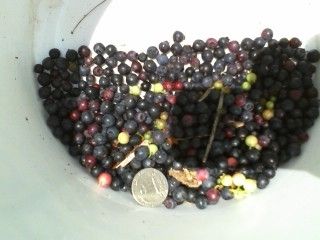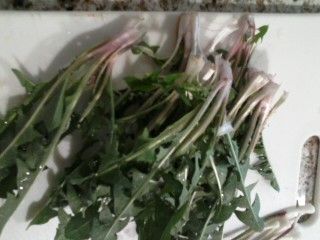odiousgambit's Blog
Expanding on an Edible LawnMarch 9th, 2017 at 4:01:05 am My lawn seems to be a naturally good choice for picking wild edibles. I don't use any poisons on the lawn and don't go after weeds, concern about perfect golf green condition being a monumental waste of time in my book. I probably want to tick off anybody who wants their lawn to look perfect anyway, hopefully they will go away and realize we can't possibly be friends. Turns out a lot of these 'weeds' are edible, the wild onion, poke, and dandelion already seen on my plate, witness other blog posts, so I am expanding the menu this year. Identified and ate what I think is "curly dock" yesterday and will also investigate "mallow". The words "I think" may alarm you, but I have the book Wild Edible Plants by Kallas, which has alleviated my fears for the most part. Basically, what grows naturally and looks anything like dandelions is not likely to harm you and is likely quite edible. The main concern is unpalatable result if the wrong thing is picked, and that you determine yourself. Additionally, eating a small amount the first time is just common sense. The book, extensive and with excellent color photos, mentions for low plants only 'scarlet pimpernel' as something to avoid. This plant is mostly a problem for livestock, being unpalatable to us, and is fairly easy to identify; looks nothing like the dandelions etc. I seem to have it in places, although it could be a false version; nonetheless it will be avoided. If I was finding wild spinach - the author is nuts about it - I'd also have to look out for 'hairy nightshade', which also is a tall plant and a look-alike to be avoided. I seem to have the nightshade in places, but no wild spinach. So I will keep you posted. Comments
|
Ants: Secret WeaponSeptember 17th, 2016 at 4:31:49 am I was replying to a brother about how I have been killing ants and decided to post it here too. _ Regarding the water, yes, an exterminator told us that too. Water has to be nearby, so if they are coming in at the ceiling area, you probably have a roof leak, and indeed we found one. Oddly, the exterminator did not seem to want to check back with us, but they went away that time when a little tiny hole in the roof was fixed. We got them later coming in along the walls, and I finally settled on the original secret weapon LOL. I think I just saw it on the shelf at the store. I found another secret weapon for the ants ... The old weapon: it still works, but relies on contact, diatomaceous earth. A place that sells a lot of insect killing stuff should have it. I can get pretty big bags at the local Farmer's Coop, not so big bags at Tractor Supply. I don't know if you want to do this? but I actually drilled holes in the wall, pushed back the insulation, and ladled it in for hotspots. They hate coming in contact with that stuff, and it is non-poisonous. Dries them out I guess. Don't get it in your eyes. In spots I had to fix the walls, and it doesnt look that great there. Behind the cabinets I just taped over the holes. This year they were figuring out how to come in and I was afraid I didn't know exactly the right spot to try the d.earth. I happened to be dealing with yellow jacket nests in the yard at the time and had some of that stuff that you spray in the hole in the ground and it is a foam. See link. It uses a little straw on the nozzle and I noticed a spot that I could slip the straw in over the sink where also the drill holing thing would be a pain in the ass. So I stuck the straw in and sprayed it good. That has been the end of those very persistent ants! Next time I might be quick to use this again, a very small hole is all that is needed. It is a poison of course, and it says nothing on the label about using it for ants or for indoors at all, so there is that to think about. This new weapon: http://www.spectracide.com/Solutions/Insect-Killers/Stinging-Insect-Killers/Spectracide-Carpenter-Bee-and-Ground-Nesting-Yellowjacket-Killer-Foaming-Aerosol.aspx Comments
|
Wild Edibles off to Slow StartJuly 4th, 2016 at 1:36:23 pm My wild edibles exploration has been pretty lame so far this year. I bought a good book for finding wild more salad-type greens, and should have been able to expand on the dandelion and onion. But honestly it has rained so much once spring started that any time I'm willing to give to 'the yard' this year has been taken up by the garden and mowing. Because of the rain, mowing has been quite a challenge this time around; of course I am up to it physically, but finding the motivation to keep up, not so much. As a result I have identified some of the things in the book and done nothing with them. One discovery on my own though is that the wild onions early on hide a very tender and tasty part in the upper part of the shoot that cannot be found in the store variety of scallions. I've come to consider it quite a real secret delicacy. I'm growing and canning a lot of collards and kale from the garden. As far as the wild edibles for that, I continue to add a smal portion of the poke I have encouraged to grow. Notorious as something poor people eat, you have to know what to do with it or you can poison yourself. We ate it when I was a kid, our family having poor people in the ancestral chain, but always mixed in with the other greens. I have actually come to think of it as an adulteration - something to mix in to stretch the quantity; probably such is the only proper use of it, and I do it as a nod to the past. Next thing will be huckleberries again, my intention this year being to try and get the timing right for the best time to pick them. Early indications do not point to a bumper crop, but stay tuned. PS: the blog the picture comes from tells an amusing story, but the author is wrong that the mere issue is the laxative effect if the poke is not thoroughly boiled and then drained and rinsed [I do it twice but some recommend 3 times]. There really is a poison involved, you can google that, and you can die eating untreated poke. Even proper treatment of the product doesn't yield something you can eat all the time. Poor people would sometimes get "poke-mouth" from eating too much and I swear I think I can remember people who had that - kind of a pale look around the mouth, along with cankers. Comments
|
Edibles again: HuckleberriesJune 30th, 2015 at 3:11:37 am  Basically wild blueberries, although technically not a blueberry, only related. Much more flavor-packed than a blueberry. Honestly, pretty miserable to pick in VA due to heat and humidity this time of year ... but for some reason I really get into it. I may or may not pick raspberries or blackberries, usually don't, but huckleberries I dig. Not sure why but probably because I don't know anyone else who does it. Yesterday it was slim pickings as you can see. Note also the berries are much smaller than commercial blueberries. The trick is to catch them at their peak, a small window for sure for that, but then it is [barely due to weather] worth doing. I can really post a lot on this subject if encouraged [you have been warned LOL] Comments
|
Dandy Edible Plant ReconsideredApril 15th, 2015 at 3:23:46 am I decided to give dandelions another try after bashing them in the last post. Didn't care for them when I tried them before, but I had tried them too late too, this is actually the time of year to do it. This time I took a tool and dug some up properly instead of half-ass. When you cut off the roots and wash them off, this is what you get.  I made a salad and sampled the dandelions 'on the side'. *The book says you should find the blanched part [next to the root] tasty but the rest maybe not. I found as I ate past the blanched it was still good, but stopped from eating it all just as you might with a green onion [scullion]. As the Spring wears on I suspect the other end gets less and less palatable. *The contribution to the salad was similar to arugula. I wouldn't want an entire salad of dandelions or arugula either one, but as an ingredient. *The nutritional value is there with various vitamins, including C. http://nutritiondata.self.com/facts/vegetables-and-vegetable-products/2441/2 *They are certainly plentiful. Final conclusion: might as well harvest some this time of year along with the wild onions. They are coming up while the regular garden is just getting started. Comments
|

